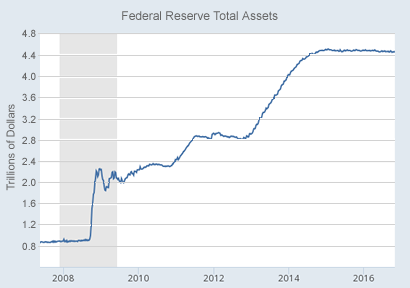Quantitative Monetary Policy
Contributor(s): Peter del Rio
Last Edited: 2016-10-28
Memorial Day, 2016
|

|
|
The Federal Reserve Act of 1913 was passed to create a government bank able to provide capital to the private banking system during a time of crisis.
Quantitative monetary policy enables central banks to have “unlimited capital” at their disposal but
for quantitative monetary policy to be effective long term, the quantitative capital added to the central bank's balance sheet must be removed.
|
If central banks wait until their bonds mature on their balance sheet, they no longer have “unlimited capital” at their disposal.
Once quantitative easing (QE) is done, the central banks must begin to unwind their QE to insure the central banks have “unlimited capital” for another time of crisis
or run the risk of the markets challenging the central banks.
In short, after QE, the central bank should normalize the money supply by reducing its balance sheet through Quantitative Tightening (QT).

|

